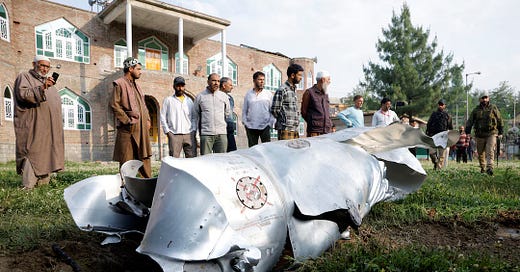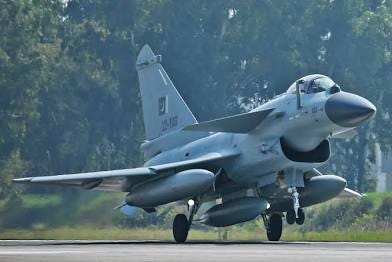The last several days the volume of pro-PRC defense rhetoric online has increased. The backdrop of much of this is the India-Pakistan conflict and India’s Operation Sindoor. Indian forces struck terror camps in Pakistan and Chinese outlets and influencers rushed to frame the story. Often, they amplified unverified claims and boasted of PLA weapons’ capabilities. In this information battleground, Chinese state-linked media and social platforms played a role in shaping perceptions of Chinese jets, missiles, and radars. I think it is worth looking at some of this “reporting” to understand the context on Chinese propaganda goals and a reality check on actual military systems.
The India-Pakistan conflict is ready made for Chinese narrative manipulation. The PLA’s doctrine emphasizes “informationised” and “cognitive” warfare. This includes PLA crafting tailored propaganda narratives targeting foreign audiences. This was an international conflict in a highly contested region involving one of the PRC’s strategic rivals who happen to use “western” weapon systems in their defense forces.
Almost immediately after India’s Operation Sindoor, Pakistani and Chinese sources asserted that Pakistani J-10C fighters (armed with Chinese PL-15 missiles) had shot down several Indian jets, even capturing pilots and crippling Indian air defenses. The Indian Embassy in Beijing publicly warned the state-run Global Times to “verify your facts and cross-examine your sources before pushing out this kind of disinformation.” Similarly, FlightGlobal magazine analyzed one viral photo claiming to show a downed Indian Rafale; it found subtle inconsistencies in the image and noted that “none of this has received official confirmation.”
That did not stop Beijing and its allied media. Nationalist voices and Chinese analysts seized on the Pakistani claims as proof of Chinese hardware dominance. They celebrated the J-10 erasing 26 years of humiliation by downing a Rafale. One Chinese scholar even framed the clash as a showdown between India’s “advanced ‘multi-national’ weapons” and Pakistan’s “Made-in-China” arsenal. These accounts were often paired with boasts about other PLA systems and discussed how China would beat any other country that goes to war to a pulp. I wonder who that message is aimed at?
This narrative actually serves several purposes. First, and most clearly, it is red meat for the very online PRC base. It allows them to tout their military success from a no-lose position. If India beat Pakistan (which by all indications they did), it’s not China’s fault, but they can claim advances and successes on the margins and amplify them. Second, the PRC is the fourth largest arms exporter in the world, the first three are 1) U.S., 2) France, and 3) Russia. Of course they are gonna focus on successes against the Rafael, they are trying to move up in the rankings. The last, is this narrative is a form of defense aimed at the U.S. and regional allies. Just look at a recent India.com piece:
Bad news for US fighter aircrafts: After India destroyed the Chinese supplied air defence systems of Pakistan during Operation Sindoor, which was recently conducted to neutralise the terrorist camps in Pakistan and PoK, the defence industry of China was shamed all across the world.
…
However, China is not willing to sit back and relax. Here are all the details about the recent announcement of China and how it is a bad news for US fighter aircrafts like F-35 and F-22 raptor.
The pivot is impressive. Within the first paragraph the author goes from a Rafael destroying a recently acquired Chinese air defense system to doomsaying U.S. aircrafts’ dominance because, reasons.
Interesting Engineering offered a deeper look at Chinese detection and potential reasons for their performance. Chinese defense companies recently gathered at the 11th World Radio Detection and Ranging Expo (World Radar Expo) and some claimed to have produced large antenna arrays able to detect not only stealth aircraft but submarines operating close to the surface of the water. This is troubling if true from a U.S. perspective as the Taiwan Strait is relatively shallow. However, we are not seeing these systems outside of expos and company announcements. We need to look back at the India-Pakistan fight to glean some insights.
A healthy dose is skepticism is a positive thing in a time of information warfare. Even the phrasing is suspicious. The India-Pakistan fight saw Chinese Gen 4.5 fighters going against French 4.5 fighters. The Chinese fighters, using more sophisticated air-to-air missiles, faired better than “anticipated.” Anticipated by whom? As The War Zone rightly pointed out:
it remains the case that claims from both Indian and Pakistani sources are conflicting, and hard evidence of how these fighters were used and how they performed overall remains elusive. It’s also worth noting that the imagery related to the air war that has been posted to social media, together with claims about possible shootdowns, should be taken as unverified. Large-scale propaganda and information operations, as well as an avalanche of social media exchanges based on vitriol, are still ongoing, and this will likely remain the case for some time to come.
We do not know how the aircraft were used. That is a glaring hole in the analysis. There are several ways that layered air defense systems and fighters can work in tandem to complicate airspace and make shoot downs more likely. Offensive counter air operations are harder in many ways than defensive ones are, in particular when you are playing with a “home field” advantage. The current narrative avoids all of this nuance and makes the India-Pakistan air war sound like Top Gun with ace against ace in a test of will and ability. That is not how air wars happen.
There is also a good deal of intentionally conflating “the West” and the U.S. defense systems. These are not the same. In this case the western weapons we are discussing are French fighters. It is possible that the PL-15, China’s air-to-air missile some reports credit with shooting down Indian fighters, is the equal or surpasses French missiles. But, that does not mean it is the equal of the U.S. systems. The U.S. has fielded two updated air to air missiles since China denied the PL-15. What this does highlight pretty clearly is we are seeing the PLA and the Pentagon build with a focus on their “pacing threats.” In this case, the French fighters are just not in the discussion.
None of this discussion is to say that the PLA and PLAAF is not capable. They clearly are creating advanced weaponry and advancing. However, the false equivalence between “western” weapons needs to stop. We are not even sure that more than one Rafael was shot down. More importantly, this was a limited engagement over a short period of time. What have we truly learned about the PLA’s military hardware capabilities? Little. But, that does not stop the torrent of online comments.
I realize I am part of the deluge but someone has to say it.






You’re not part of the deluge. This is levels above it. Keep it coming and thank you for doing so.